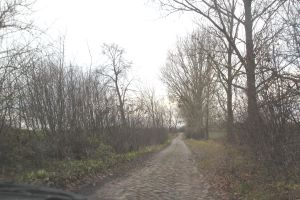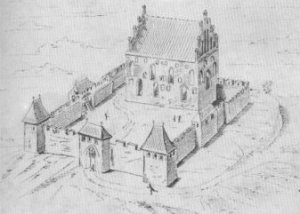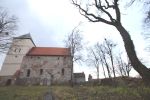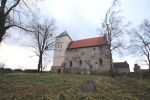I insisted on going to Bezławki (Bäslack – former East Prussia).
We had to get back from Giżycko (Lötzen) to Galiny (Gallingen) anyhow and somehow. We could very well go through Bezławki then…
On our way we stopped in Ryn (Rhein) to have some lunch. However we did not eat in the castle, but in an inn “At Wallenrode’s” (of course they must have meant Frederick Wallenrode, the brother of the Grand Master).
Unfortunately they have their site in Polish only, but the food there is worth international attention! It is more than delicious! They serve a really juicy port steak there!!!!
And the food has all the best features of the Polish food so much desired by the foreign tourists.
Going back to Bezławki…
So as not to drive through Kętrzyn (Rastenburg), we chose a shortcut. However, quite a good asphalt road ended after a while. Now we drove a beautiful, but very bumpy cobblestone route, perhaps remembering the times before World War I, when it has been laid. Just as it was made, it never had been rearranged since.
I remembered my memorable ride across Żuławy (Werder) near Malbork, when first the asphalt ended, then the cobblestones remained only in memory, and finally even the country road ended. I also remembered one of our shortcuts to the Zubrzyca Górna when the road ended (literally) in the barn… The mere memory of the astonished cows – made me want to laugh.
But I strongly believed that our Holy Grail quest would not end in such a way. Because it is that story – or if you prefer – legend, that drove us to Bezławki.
But first – few historical facts.
Bezławki emerged into the history in the half of the 14th century. It was when Johann Schindekopf – the then Commander of Balga and mayor of Natangia bestowed land and mill to one of his subjects.
This particular commander also located Kętrzyn (meaning – granted civic rights to this settlement).
Schindekopf’s bestowal still exists in a changed form…
Well, the Commander in his generosity, gave to a certain Henikin of Gerdauen (todayZheleznodorozhny in today’s Kaliningrad Oblast’) a water mill with one wheel on the river Dajna). That was not all – Henikin also got 6 morga (I couldn’t find its name in English) of land on the Kulmian Law. As far as I remember, Kulmian Morga is ca. 0,59 ha, which equals ca. 1,46 acres.
The said mill functioned till 1974, when it was turned into a small hydroelectric power station.
This bestowal was connected with the colonization of this part of the monastic state. It was here – in the borderland that a number of settlements, villages and farms as well as castles were built to protect the settler from the incursions of the Lithuanians. And Bezławki perfectly fitted in this borderland system of watchtowers. It was build replacing a former settlement. It was governed by a bailiff subject to the prosecutor in Kętrzyn. The location privilege the settlement called Bayselauke (i.e. Bayse’s field) received after Schindekopf’s death at one of the battles in 1470’s. Until today, no date is set for construction of the castle. As a photo of the information board I took is not very clear, so I am making use of sketches found on the web… And they are by – whose else if not Conrad Steinbrecht 🙂
The castle was built on a hill (even today quite difficult to access), probably in the early 15th century. It is known that in 1402 Wilhelm von Helfenstein (the Grand Commander in Malbork) stopped in Bezławki castle on his way back from the raid to Lithuania. It is said that he had with him 900 prisoners of war (I wonder where they were kept and how they were managed) Also Duke Švitrigaila stayed there. He was the youngest brother of Jagiello (the King of Poland) and he was fighting on the side of the Teutons. He dreamed of power in Lithuania – independent of his older royal brother… He stayed in Bezławki till 1404. I will not describe the castle, because this can be found both in books and in the net. After the Polish-Lithuanian-Teutonic War often called the Great War (1409 – 1411), the castle began to lose its importance, and in the 16th century was turned into a church. Even after World War II it served the Protestants (up to 1970s). After there was no more of this faith it was abandoned and deteriorating, falling prey to vandals and thieves (the nihil novi in these areas.) When finally in the 1980s the building was taken over by the Roman Catholic parish in nearby village of Wilki, it was renovated. But part of the equipment is gone forever, either stolen or destroyed earlier by the thieves.
Was it a Greek chalice that was sought-after by the thieves? It was mentioned in chronicles as given by Švitrigaila to the Knights. The inventories also mentioned the Greek (Ruthenian) altar frontal. Was there among the stolen things the famous Holy Grail?
We shall never know. But the legend of the castle mentions it…
Well – the whole story began in England, where from supposedly the Holy Grail was to be taken to Lithuania. I will not describe the whole legend of the Holy Grail – it can be found both in books and on the web. I will start almost from the end of history, from the Battle of Hastings. So, after the Battle of Hastings (1066) three of the children of King Harold Godwinson had to flee from England to save their lives. As the legend says – they went through Lithuania, Kiev to Byzantium. Gytha of Wessex was married to Waldemar, the king of Ruthenia, known as Vladimir II Monomakh. He was one of the most famous rulers of Kievan Rus. The two sons of Harold – as the legend says – stayed in Lithuania. And Godwin, the older of sons is said to have been the ancestor of Jogaila (king Władysław II Jagiełło)…
According to some legends and stories, the altar frontal as well as the chalice was Švitrigaila’s gift to the Knights. In fact there were two chalices – the English one and a Greek one. The Greek chalice was given to the Teutons while the English one was taken away by Švitrigaila. Would it have been an heirloom then?
The treasure hunters claim that the Greek chalice was the famous and mysterious Holy Grail, referring to this part of the history, completely ignoring the logic… Well logic says that nobody would have given away SUCH a valuable item, and least of all people – Švitrigaila. Also it is very doubtful that he would have been in possession of such a family treasure, being the youngest of the family. But, as we know – we do not fight against legends – we tell them…
During the last Polish-Teutonic war in 1520s the chalice was mortared in the church, so as to save it from Tatars, plundering around. Was it this that was found in the wall, after what a significant hole was left??
But this place is not only the complicated legend of Holy Grail.
In the 16th century the ownership of this land goes to the von der Groeben family. I would like to point that not far from there is Św. Lipka. And these areas were the ones sold to Stefan Sadorski by Otto v.d. Groeben to enable building of the today famous Marian sanctuary in Św. Lipka.
The Bezławki castle has a unique atmosphere. It is far from the main tourist routes. On one hand it is good, but on the other hand the lack of supervision does not do the place any good.
Anyway – this is definitely a place worth a visit and returning here in the season of the larks, when the place is filled with bird twittering. A gloomy autumn day after rain, no leaves on the trees, wind, and the voices of crows and jackdaws made a specific atmosphere of the place during our visit there. It is easier then to believe in legends, hear the voices 😉 and to find A Brick…







